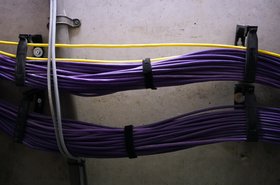An investigation carried out by the Wall Street Journal has accused US operators AT&T, Verizon, and other telecom companies of contaminating US water and soil with toxic lead cabling.
According to the WSJ, the toxic lead can be found on telecom cables installed underwater, in the soil, and on poles. The investigation has found that as the lead degrades over time it is released into the water, soil, and air.
The investigation collected samples from various parts of the country where the lead could be found, including on the banks of the Mississippi River in Louisiana, the Detroit River in Michigan, the Willamette River in Oregon, and the Passaic River in New Jersey.
In total, the test samples from nearly 130 underwater-cable sites, conducted by several independent laboratories, were found to be toxic.
WSJ states that its investigation revealed a hidden source of contamination in more than 2,000 lead-covered cables that haven't been addressed by the companies or environmental regulators.
Although US mobile operators haven't used cabling containing lead since 1964, old cabling is typically left in place when traditional cabling is replaced with fiber, says WSJ.
The use of lead within US telecom cabling dates back even further, to the 1880s, initially starting as a way to sheath and protect copper wires from exposure to the elements because lead is very stable and does not rust.
At the time, lead was considered a state-of-the-art material and strong enough to guard the interior copper wires providing the critical communications infrastructure the public relied on. However, these lead-sheathed telecom cables would gradually be phased out from the 1950s.
Alleged knowledge of the dangers
The WSJ article claims that both AT&T and Verizon knew that the cables were toxic but have chosen to not remove them.
In another article, the publication cites documents and former employees as evidence that the two telcos knew of the dangers of lead cables. It's even reported that AT&T officials have voiced their concerns around exposure to the cabling when carrying out work.
US health agencies note that risks from the cabling include kidney issues, heart disease, and reproductive problems in adults. No amount of the metal is deemed safe, whether ingested or inhaled, particularly for children’s physical and mental development, according to doctors. Lead can stay in the blood for two or three months, but can be stored in organs and bones for decades.
DCD contacted both operators for comment and was directed to US Telecom Association, a body that represents telecoms businesses in the country.
Attempting to defuse the claims, the Association posted a statement around lead cabling on its website.
"The US telecommunications industry takes the health and safety of our workers, neighbors, and the communities in which we live and operate very seriously, and we remain committed to prioritizing worker and community safety," said the trade association.
"The use of lead alloys in telecom cables started in the 1880s and the industry began to phase out placement of new lead-sheathed cables in the 1950s after developing a new type of sheathing. Some of these cables still provide customer voice and data services, including connecting 911 service, fire alarms, and other central monitoring stations. We have not seen, nor have regulators identified, evidence that legacy lead-sheathed telecom cables are a leading cause of lead exposure or the cause of a public health issue."
AT&T has created a dedicated section on its website around legacy cables, acknowledging the WSJ investigation.
"The health, safety, and well-being of our people, our customers, and our communities is of paramount importance. For decades, we have managed legacy lead-clad cables in compliance with applicable laws and regulations, and we have followed industry-wide best practices to maintain this legacy infrastructure in a way that’s safe for all based on established science," said the company.
The operator added that it disputes the research and report published by the WSJ, accusing the publication of flawed testing methodologies, while also being compromised by a conflict of interest.
"We take the matters raised by The Journal very seriously, and any public health concern is a top priority. It’s important to note that The Journal’s reporting conflicts not only with what independent experts and long-standing science have stated about the safety of lead-clad telecom cables but also our own testing, which we have made available to the public and shared with The Journal. The scientific literature and reliable studies in the US and abroad give no reason to believe that these cables pose a public health issue or a risk to workers when appropriate safety measures are in place.
"Any new scientific data needs to be studied further before arriving at conclusions about public health and safety related to these cables. Should there be a need for further analysis of this topic, we will work collaboratively with industry peers and other stakeholders and act responsibly."
Lead remediation could cost $60 billion to fix
In the wake of this report, New Street Research estimates that if action is required to remediate the alleged dangers of old lead-encased copper telecom cabling could cost in the range of $60 billion.
For context, this figure dwarfs the $42.5 billion put forward by the US government as part of its BEAD program, which aims to boost nationwide broadband coverage.
“If I were a governor, I’m not sure how I would feel about giving a company several million dollars, knowing that they haven’t told me yet whether or not they’re poisoning some of my citizens,” said New Street Research policy advisor Blair Levin, via a livestream with reporters and investors earlier this week. “Governors may use the BEAD process to at least get information,” Levin said.
Remediation would be a big headache for AT&T according to analysts, which estimate costs at over $34bn. Lumen and Verizon are estimated to face possible remediation costs of over $8bn.







